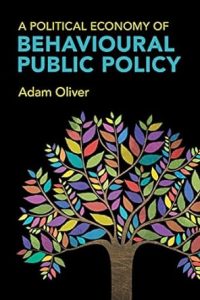In A Political Economy of Behavioural Public Policy, Adam Oliver argues for a liberal framework that rejects the use of behavioural insights to create policies that influence people against pursuing potentially harmful actions. Sanchayan Banerjee recommends the book as a refreshing look at liberalism in behavioural public policy and essential reading for anyone looking to delve deeper into the field.
A Political Economy of Behavioural Public Policy. Adam Oliver. Cambridge University Press. 2023
 In A Political Economy of Behavioural Public Policy, the last of the trilogy on behavioural public policy (also see Oliver, 2017; 2019), Adam Oliver proposes a liberal framework of behavioural public policy, which recommends against the use of behavioural insights for regulation, coercion, and manipulation, so long as people do not impose substantial harms on others by pursuing their own desires.
In A Political Economy of Behavioural Public Policy, the last of the trilogy on behavioural public policy (also see Oliver, 2017; 2019), Adam Oliver proposes a liberal framework of behavioural public policy, which recommends against the use of behavioural insights for regulation, coercion, and manipulation, so long as people do not impose substantial harms on others by pursuing their own desires.
Behavioural public policy is largely dominated by narratives of soft paternalism, often referred to as ‘libertarian paternalism’.
Behavioural public policy is largely dominated by narratives of soft paternalism, often referred to as “libertarian paternalism”. This is the idea that governments can regulate the means by which people make choices (“paternalism”) without necessarily regulating their ends (“libertarian”). For example, employees can be defaulted into a higher savings scheme, with an option to opt out if they so desire. Libertarian paternalists argue this nudge helps employees improve their welfare by increasing lifetime savings – a goal that is assumed by the policymaker to be true for all individuals.
[Oliver] argues to the likes of many classic liberals who have come before him, such as Mill, Smith and Hume that what is desired by individuals can only be judged best by themselves.
Oliver challenges this notion of one “common (private) goal” on liberal grounds. He argues to the likes of many classic liberals who have come before him, such as Mill, Smith and Hume that what is desired by individuals can only be judged best by themselves. While it is possible that libertarian paternalists might be able to identify such goals, it is nonetheless quite unlikely.
Based on these arguments, Oliver claims that a one-size-fits-all nudge that prescribes only one common goal for all does not sit well within Millian liberal principles, for such a nudge can never likely advance all individual goals. Through a careful review of the different accounts of human welfare, Oliver introduces the reader to the lopsided, monistic view of utility, despising its use as a policy compass given the wide scholarly disagreement on its meaning and measurement. Instead, he argues in favour of individual autonomy for each to promote their own ends, so long as they do not impose harm on others in pursuing their own self-interest. Thus, the main premise of his political economy is based “on [a fair and just] interference in the exchange relationship [between two actors], not on whether a good or service is deemed as a good or bad thing… from a paternalistic perspective” (139).
Regulating people towards one private goal, which conforms to some socially acceptable welfare standards, will undermine people’s autonomy and crowd out human reciprocal tendencies, which then can have negative long-term consequences.
Oliver also questions the validity of the “heuristics and biases” paradigm guiding nudge applications. This is the view that individuals make systematic errors (“biases”) from the shortcuts they follow (“heuristics”). Oliver defends such “irrational” human choices as a psyche that has necessarily evolved over time for a reason, and, therefore, must be left as such. His analogy, relating the origins of risk- and loss-aversion to the scarcity and abundance of food in hunter-and-gatherer times, speaks to the richness and interdisciplinarity in the scope of behavioural public policy. Driven by such evolutionary justifications, Oliver argues that humans almost naturally engage in reciprocal relationships (conditional give and take) and respond to the desert, a reward that guides their decisions ultimately. He is of the view that regulating people towards one private goal, which conforms to some socially acceptable welfare standards, will undermine people’s autonomy and crowd out human reciprocal tendencies, which then can have negative long-term consequences. However, like his liberal predecessors, he acknowledges the harm that individuals can impose on others in securing a reciprocal relationship, which he calls for to be regulated instead.
Oliver suggests that reciprocity must be nurtured at all costs, for that is what governs all human behaviours.
Based on these arguments, Oliver suggests that reciprocity must be nurtured at all costs, for that is what governs all human behaviours. This also leads him to the main thesis of the book: Regulate, but only against externalities. He closes the book by summing up his thesis with a parallel to the Millian maxims from On Liberty.
In summary, Oliver offers a refreshing take on liberalism in behavioural public policy, which he contrasts against other existing frameworks, like nudging, boosting, nudge+, and shoving. Even though Oliver initially cautions that his work is not a “trade book” and asks readers to invest effort, he skilfully guides us through, offering pertinent examples and incorporating the arguments of his classic liberal predecessors when needed. He also speaks to many important conceptual issues in behavioural public policy. One, for example, is found in his critique of the concept expansion of “nudge” and consequently in his ask to set clear boundaries for different frameworks, which he does coherently with the behavioural policy cube. The other, which is a running theme of the book, is his call to preserve and promote human autonomy, which largely resonates with the manifold behavioural agency approaches that have been put forward by different behavioural policy analysts recently. On a more pragmatic note, Oliver ends the book with an honest disclaimer, where he recognises the limits to his liberal framework in totality. However, in a world where restoring liberalism in its entirety is a utopian dream, other approaches like nudge+ take us closer to liberal principles than that proposed by Oliver.
Oliver […] recommends regulation in favour of externalities, that is, when an individual imposes harms on others with his actions, but not against internalities, that is when the individual harms himself only.
As someone who identifies as a libertarian and supports policies promoting individual autonomy, it’s challenging to find fault with Oliver’s overarching argument. Nevertheless, there remains one unresolved issue in the book that appears to undermine the practical implementation of the liberal framework. Oliver, heavily influenced by the Mill’s harm principle, recommends regulation in favour of externalities, that is, when an individual imposes harms on others with his actions, but not against internalities, that is when the individual harms himself only. Surely for many actions we can consider, this distinction between what causes harm to purely one’s own self versus others is blurred. For example, excessive red meat consumption, in full conscience, can lead to personal health problems and worsening climate conditions. Similarly, smoking cigarettes, can deteriorate one’s own health and also worsen air quality for a passer-by. Even, in the example of not saving enough, if individuals prioritise other ends, they can drain state resources by imposing excessive costs on healthcare in societies where Medicare is both privately and publicly provisioned.
In all these cases where internalities and externalities are tied to one single action, we cannot apply Oliver’s black-or-white principle of either regulating using behavioural insights or not.
The book does not discuss such cases at length, except for a passing example (108), where Oliver briefly considers the harm that one imposes on society by eating too many doughnuts, but then is quick to rule it out on grounds that such people are either likely to make up a small proportion of the population or their harms on society are difficult to monitor. In all these cases where internalities and externalities are tied to one single action, we cannot apply Oliver’s black-or-white principle of either regulating using behavioural insights or not. Thus, the liberal framework does not provide sufficient means to judge the appropriateness of behavioural regulation. By Oliver’s account, many of these actions, which will create both internalities and externalities, will still count as blameworthy, though to varying degrees. So, it remains to be worked out when such actions deserve behavioural regulation.
These opposing viewpoints do not diminish the merits of Oliver’s proposed liberal political economy of behavioural public policy. Rather, they introduce fresh perspectives for dialogue.
These opposing viewpoints do not diminish the merits of Oliver’s proposed liberal political economy of behavioural public policy. Rather, they introduce fresh perspectives for dialogue, which contribute to the vitality and depth of emerging fields such as behavioural public policy. In fact, addressing the limitation above will make the case for this liberal framework stronger. Consequently, the book, and the trilogy as a whole, becomes essential reading for anyone eager to delve deeper into the realm of behavioural public policy.
Note: This review gives the views of the author, and not the position of the LSE Review of Books blog, or of the London School of Economics and Political Science. The LSE RB blog may receive a small commission if you choose to make a purchase through the above Amazon affiliate link. This is entirely independent of the coverage of the book on LSE Review of Books.
Image Credit: Olga Danylenko on Shutterstock.







